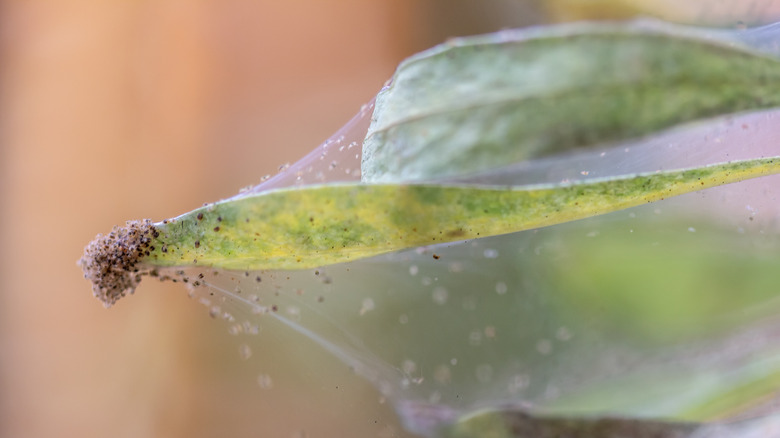Is Castile Soap The Answer To Spider-Mite-Free Houseplants?
Having houseplants in your home can be a rewarding experience that elevates the aesthetic of your space. Unfortunately, caring for indoor plants also comes with a cost: pests. Spider mites, for example, are common pests that commonly live on the underside of leaves, often infesting plants in dry and warm environments. Stressed or weakened plants are more prone to infestation, and some are naturally more susceptible to spider mites, including houseplants like palms, calathea, and ficus varieties. These pests feed on plant juices by piercing cells with their mouthparts, causing stippling, discoloration, and, if left uncontrolled, potential damage and defoliation. Regularly monitoring and addressing environmental factors that contribute to stress can help prevent spider mite infestations. Additionally, using Castile soap to make a DIY spray can also aid in managing infestations.
While soap sprays can help to mitigate spider mites, it's best to prevent infestations in the first place by practicing a vigilant care routine. Regularly inspect plants for signs of stress, discoloration, or stippling, as these may indicate an early infestation. Maintain adequate humidity levels, particularly for indoor plants during periods of low humidity. Moreover, provide adequate spacing between plants to improve air circulation and periodically wash plants with a gentle spray of water to dislodge potential mite populations. Quarantine new plants before introducing them to established collections, reducing the risk of introducing pests. These precautions collectively contribute to creating an environment that discourages spider mite infestations and promotes overall plant health.
How to use Castile soap on your plants
To create a DIY soap spray using Castile soap for getting rid of spider mite infestations on plants, gather the necessary ingredients: Castile soap, water, and a spray bottle. Choose a pure Castile soap without any added fragrances or chemicals, as these may harm the plants. In a clean spray bottle, add a solution of 1 tablespoon of Castile soap per 2 quarts of water. Shake the bottle vigorously to prevent the soap from concentrating, which may potentially harm sensitive plant tissues.
When applying the soap spray to infested plants, do so during the early morning or late afternoon to avoid direct sunlight, as this will cause the solution to evaporate faster. Lightly coat the affected plant surfaces, ensuring coverage of both the upper and lower leaf surfaces, as spider mites often reside on the undersides. Then, repeat the application every few days until the infestation is under control — without oversaturating the plants. Consistency is key, as spider mite eggs may hatch over time, necessitating continued treatment as the soap solution only kills bugs on contact.
Regularly inspect plants for any signs of reinfestation, and adjust the frequency of the soap spray application as needed. Additionally, monitor plant health to ensure they are not exhibiting adverse reactions to the soap solution and stop applications if they do. Following these steps, you can effectively utilize Castile soap to create a homemade spider mite deterrent and maintain the well-being of your plants.
Why Castile soap works
Castile soap is an effective and safe solution for eradicating spider mites due to its unique properties. Spider mites, tiny arachnids that infest plants, have waxy coatings on their bodies, which helps them retain moisture. Castile soap, when used in a DIY spray, disrupts this coating by breaking down the waxy substance. This interference compromises the mites' ability to retain water, ultimately leading to their dehydration and death. The soap's mild yet efficient action makes it an ideal choice for treating plants without causing harm to them.
One of the key advantages of using Castile soap is its biodegradability and lack of harmful chemicals. This makes it safe for houseplants, as it won't leave behind toxic residues that may damage or stress the plants. The soap targets the spider mites while being gentle on the plants, preserving their health and vitality.
However, if the DIY Castile soap spray doesn't seem to be effectively controlling the spider mite infestation, it may be time for alternative measures. Explore other natural remedies, such as neem oil or commercial insecticidal soap, but be cautious about their potential impact on certain plant species. If the problem persists, consult with a local gardening expert or extension service for personalized advice and potentially consider introducing predatory mites, which can act as natural enemies to the spider mites. Combining these measures can provide a more comprehensive approach to controlling and eliminating spider mite infestations on plants.


